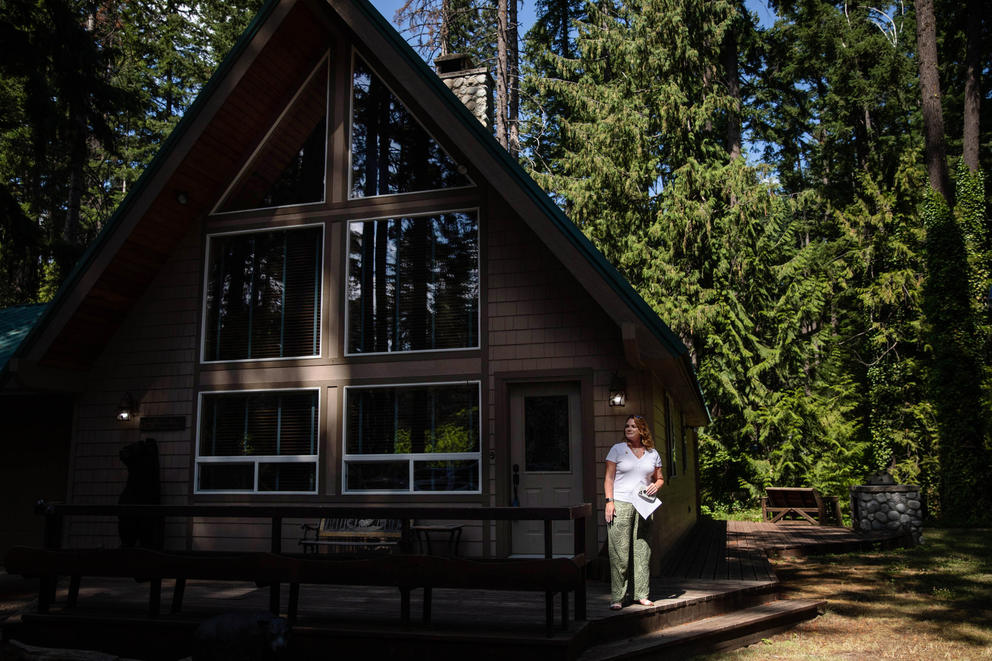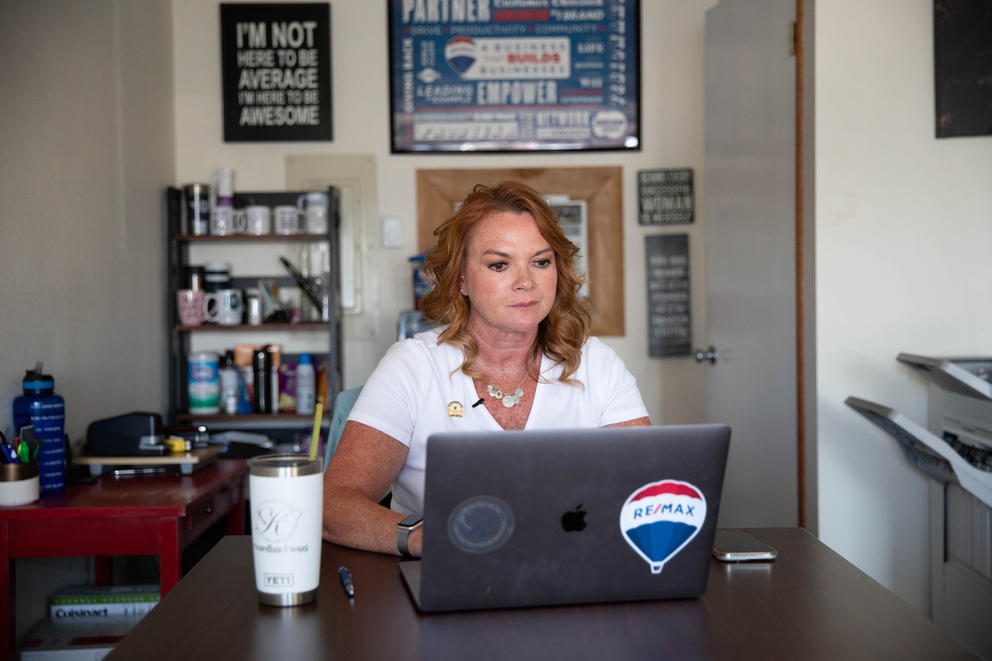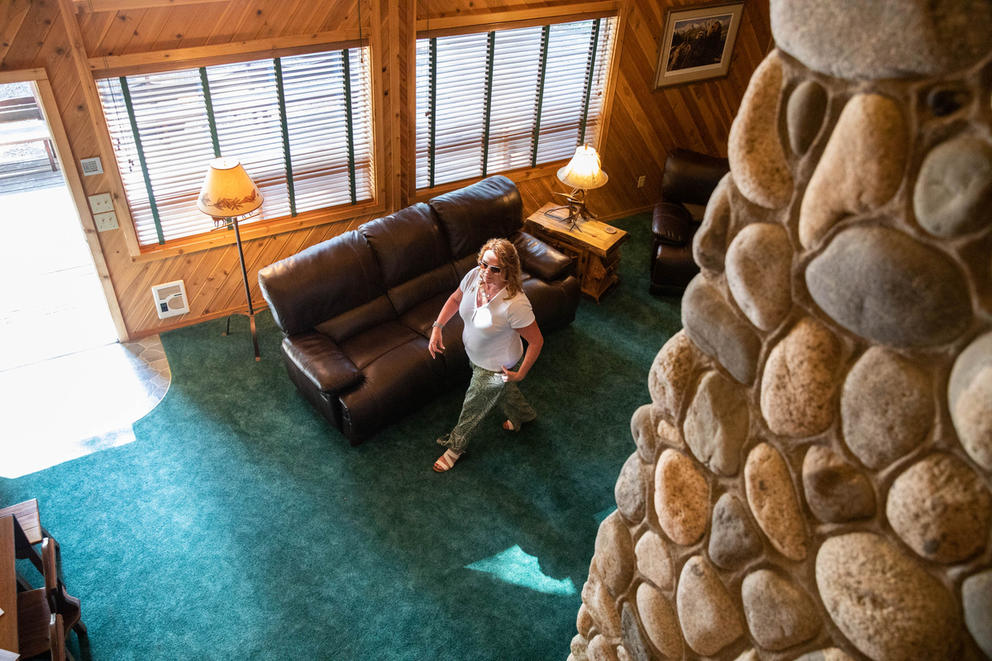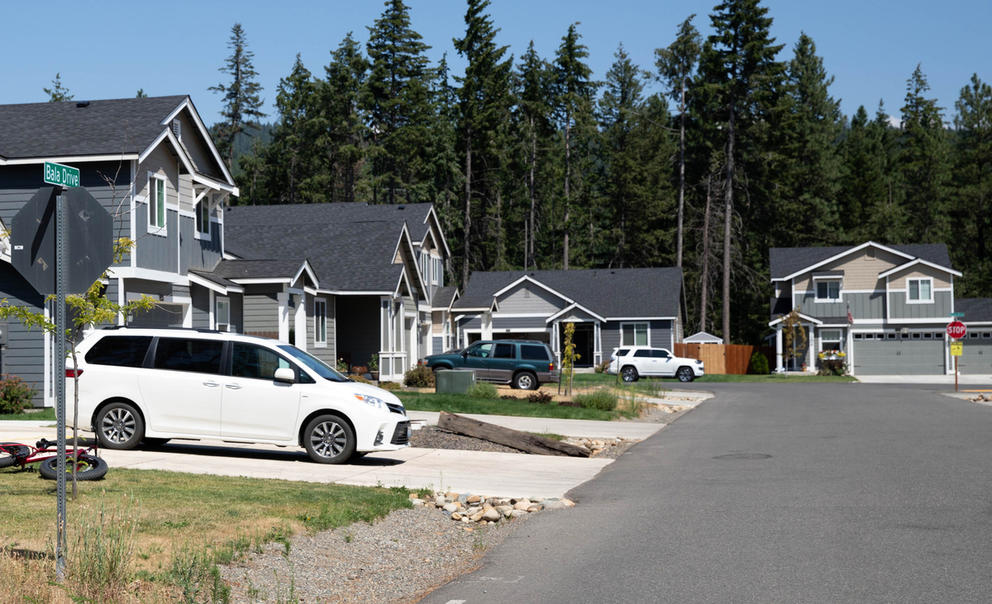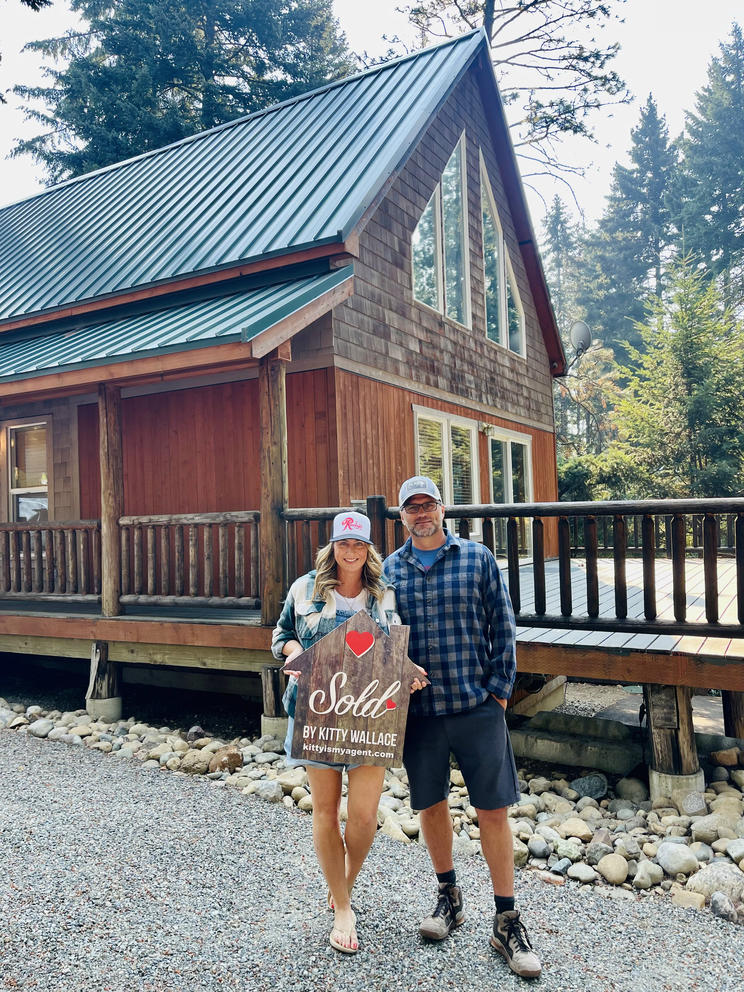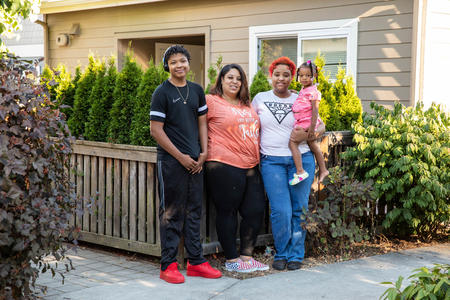As an adult, she had the best of both worlds: the energy and culture of living in downtown Seattle, where she worked as a technology consultant, and the quiet and tranquil life when she visited Kittitas County. “It’s always been a place of peace and sanctuary,” she said.
But things got off-balance during the COVID-19 pandemic. Bender was confined to her downtown Seattle apartment when she started working remotely. The restaurants and cultural events she once enjoyed were closed due to restrictions, and when she could go out, she felt less safe with the growing presence of homelessness and drug use in her neighborhood.
This story is part of a Crosscut focus on housing: Making Seattle Home
During the early days of the pandemic, she started to consider whether it was time to leave Seattle. And when she began looking for homes, she knew where to look first: Kittitas County.
“There are many beautiful things about the city,” she said. “[But] I needed to make a change that would allow me to feel at peace in my home and community.”
When the pandemic limited travel and forced many professional workers to work remotely, many city-dwellers like Bender sought retreat in the mountains, trails and waterways of Central Washington. Chelan and Kittitas counties were a short car ride away.
In the same places Seattleites found recreation and retreat, demand for second homes — and even permanent single residences — soared. That drove, in turn, a massive increase in home prices in Chelan and Kittitas counties, making them the most expensive counties east of the Cascades.
Chelan and Kittitas counties reported median sale prices of $636,800 and $559,400, respectively, at the end of June 2022, according to the Washington Center for Real Estate Research, based at the University of Washington’s Runstad Center.
Those prices are by far the highest for counties east of the Cascades, and they nearly match those in some Western Washington counties. The median home price in Pierce County, for example, was $579,900 at the end of June this year.
“We're not as cheap and affordable as we used to be,” said Kitty Wallace, managing broker of RE/Max Integrity in Cle Elum.
Big change over two decades
When Wallace started selling real estate in Cle Elum in the early 2000s, the communities of Roslyn and Cle Elum — known as upper Kittitas County — began attracting Western Washington residents seeking an alternative to the long commutes and traffic that came with living in the Seattle area.
One can drive from Seattle to the two communities — easily accessible from several exits on Interstate 90 — in about an hour and a half. With many Puget Sound residents already spending one to two hours each way in traffic, some decided they preferred to make that drive end in a smaller and more affordable community.
The median price for homes sold in Kittitas County was $250,000 during the second quarter of 2008, during the Great Recession, less than half the cost of those over a decade later. With King County’s median price in 2008 nearly double, $450,000, one could get a much larger home in Kittitas County with proceeds from a home sale in Seattle.
And many new residents worked out deals with their employer to work from home — it was a time when working remotely was not as common as now — limiting the number of days they would have to drive to the city.
“You [could] get to your job quicker than somebody coming from Olympia driving into the city,” Wallace said.
Meanwhile, there was another development in the early 2000s: the construction of Suncadia, the four-season resort just outside Roslyn.
While Kittitas County had plenty of popular spots for activities such as hiking, camping and fishing in the summer and snowmobiling and cross-country skiing in the winter, the area wasn’t exactly a vacation destination. Many saw the area as a rest stop or a place to drive through, Wallace said.
The developers behind Suncadia looked to change that. The resort wanted to offer a variety of year-round activities and amenities, such as an ice rink in the winter and a swimming pool in the summer. And with a variety of single-family homes and condo options, Suncadia was expected to boost the region’s second-home market.
However, the resort’s 2005 opening landed a few years before the recession, which dried up real estate markets for several years. “We saw a lot of things go into foreclosure,” Wallace said.
After a slow recovery, the real estate market in Kittitas County picked up again. People started looking at homes in Kittitas County again, including in Suncadia.
But then the COVID-19 pandemic arrived. With initial pandemic restrictions limiting real estate activity, Wallace anticipated a lean market. “I was prepared to hunker down and save all my pennies,” she said.
Instead, real estate brokers have weathered a frantic real estate market during the pandemic.
“Our demand just intensified during that first year of COVID,” said Sheri Bay, managing broker and director for John L. Scott Real Estate, which has several offices in the area.
Part of the demand came from the second-home market. With pandemic restrictions limiting travel and activities, outdoor recreation became popular, making Kittitas County and other Eastern Washington areas with ample recreation options desired destinations. Suddenly, high-end homes, like those in the Suncadia resort, that were once in the high six figures were now going for $1 million to $2 million, Wallace said.
Meanwhile, some Washingtonians facing remote work indefinitely decided it was time to relocate to the area permanently, Wallace said.
Unlike the early 2000s, when Western Washingtonians moving eastward were retired or nearing retirement age, this new group of pandemic-era residents were technology workers in their 30s and 40s, Wallace said. They were workers at Microsoft, Amazon and other well-known tech companies.
While Kittitas County became far less affordable compared to 10 years ago, it was still reasonable compared to King County, where the median sale price was pushing $1 million, according to the Washington Center for Real Estate Research.
“We’re still affordable in that aspect. Keep in mind, you won't have to commute for employment,” Wallace said. “So if you have the ability to work from home, then this might be a good spot for you.”
As a result, many looked at homes, creating a fierce market, Bay said. Buyers, determined to get a winning offer, were often willing to pay well above the list price and even forgo contingencies such as a home inspection to make their bid more appealing, she said.
“As a broker, my job is to say, ‘You should not write an offer without a home inspection,’” Bay said. “But, by the way, if you don’t [leave out the home inspection], you won’t get the house.”
Prices have soared: Between the end of June 2020 and June 2022, the median sale price for Kittitas County went from $403,000 to $559,400, a 39% increase over two years, according to data from the Washington Center for Real Estate Research.
Bender, the downtown Seattle resident, started looking for a new house around this time. In this frenzied market, she lost out on three homes to winning bids upward of $75,000 above the list price.
She decided to pause her efforts. “It was really frustrating,” Bender said.
A new lifestyle in Lake Chelan
While the Roslyn/Cle Elum area has established itself as a vacation spot in only the past two decades, Lake Chelan has been an established vacation spot for nearly a century.
Lake Chelan, a natural lake that spans more than 50 miles, is located in northern Chelan County and surrounded by the city of Chelan and several unincorporated areas.
Businessman Adam Rynd has called Chelan home for a decade. Like many Puget Sound residents, Rynd spent many summers growing up at Lake Chelan.
Those visits continued when Rynd raised a family of his own in Western Washington and worked for various tech companies. In 2010 he and his wife purchased a vacation home in the area and relocated there full-time in 2012.
Today Rynd owns or co-owns several businesses, including a winery and a toy store.
He also runs Coldwell Banker Cascade Real Estate, which has offices in Chelan, Wenatchee, Winthrop, and Goldendale.
“I just really enjoy helping people and helping them manage big transactions in their lives,” he said.
Over time he’s seen more Western Washington families purchase property in Chelan County. He’s worked with many of them, selling a number of homes at The Lookout at Lake Chelan, a new residential community that offers amenities such as a swimming pool and bike trails.
Others are relocating to Wenatchee, the most populous city in Chelan County, to get a jump on emerging industries — namely agricultural technology, cryptocurrency and even diamond production — or to have easy access to comprehensive health care during retirement, Rynd said.
In both cases, quality of life, including easy access to a variety of recreation and little traffic, is a factor for many to relocate from the Seattle area. Rynd notes that many recent homebuyers he’s seen in Wenatchee and Chelan have relocated from downtown Seattle.
“I think it's lifestyle-driven. … the issues with density. Frankly, rioting, homelessness, a sense of lawlessness in certain areas,” he said. “There's a desire to get more space. Have a lifestyle that is less stressful.”
However, Chelan County did not have enough homes for the existing local market, let alone to supply a market driven by new residents from Seattle and other parts of the U.S., said Steve Bishop, managing broker for Premier One Properties, a real estate firm in Wenatchee.
As a result, homes on the market received multiple offers that drove up prices drastically. The median home price in Chelan County went from $391,500 at the second quarter of 2020 to more than $636,800 two years later, a whopping 63% increase.
A few years ago, selling a $1 million home in Chelan County would take some time. Now a home at that price is expected to be gone within a few months, Bishop said. A half-million dollars is required these days to buy an average house; even more is needed for high-end homes in vacation areas such as Lake Chelan.
Bishop, who has worked in real estate for nearly four decades and sold homes to multiple generations in the same family, said he’s seen real estate in Chelan County change drastically. “We were very much a regional market; local economics pretty well drove value,” he said. “[Now] we’re impacted by things that are beyond our control outside of the area. That makes it less predictable.”
Affordability matters
Affordability may seem irrelevant to homebuyers who can buy homes in the high six figures or even above $1 million. However, real estate brokers in both Chelan and Kittitas County said that even high-end buyers can be priced out.
If those buyers purchase homes at lower price ranges, that downward activity may ultimately lead to homebuyers with smaller budgets being unable to buy a home entirely, said Bishop, the Wenatchee real estate broker.
Tourist areas in Kittitas and Chelan counties such as Roslyn, Cle Elum, Chelan and Leavenworth need workers for services such as restaurants and grocery stores. Local service workers who often earn far less than tech workers are getting priced out of buying homes or even renting, said Wallace, the Cle Elum real estate broker.
“You have to have the service sector be able to afford to live here,” Wallace said. “Especially with the price of gas. They can't be commuting from a less expensive area and work here because it's just not going to pencil out for them.”
More housing is being built in Kittitas and Chelan counties, but much of it is not within reach of low-income or middle-income residents, said Bay, the John L. Scott managing broker in Cle Elum.
In Kittitas County, new home construction includes custom homes in Suncadia that cost $1 million or more. Even home developments elsewhere in Cle Elum come in a half a million each.
Rynd, the real estate broker in Chelan, said he’s worked on projects with a local housing trust, such as one in Chelan that provided five townhomes at an affordable price. The two-bedroom homes cost $200,000, well below the nearly half-million median prices for homes sold in April 2021, when the project was completed. The much lower price was possible by having the buyer lease the land from the housing trust but own the home. “The challenge is trying to scale that,” he said.
There’s general agreement that local and statewide planning and zoning regulations could also impact a community’s ability to bring in additional home stock.
Bishop said he’s seen government officials give lip service to affordable housing, then make it difficult for builders to finish projects on time. He said he’s not against reasonable regulation, such as those that ensure a home’s design or zoning isn’t disruptive to neighbors. Still, he feels that implementing additional requirements — such as barriers for sidewalks in areas that previously never required them— can be excessive and only hamper the building pipeline.
In Kittitas County, Wallace said she would like officials to look into zoning that would allow the construction of duplexes and different kinds of multifamily housing. Most existing construction is for custom single-family homes. As a result, the home supply in the area consists of large high-end homes and older, smaller 1,500-square-foot homes but not much in between, Wallace said.
What is not being built is the spec homes that were being built across the U.S. for first- or second-time homebuyers in the 2000s, she said.
However, while affordability continues to be an issue, there is some relief. While prices have continued to appreciate, they have not been increasing at the same rate as a year ago. Instead of pushing 50%, appreciation is usually between 4% and 10%, Wallace said.
Bay, the John L. Scott managing broker, said that’s partly because more homes are coming onto the market. Interest rates also increased, which slightly tempered the market. As a result, buyers in the market now are more likely to look for homes at a less frantic pace.
Bender, the downtown Seattle resident, resumed her home search more than two months ago. She again made offers that did not pan out. But then a home came on the market a month ago, a cabin-style house in a local golf-course community.
She had to pay a little more than she planned and at a higher interest rate than when she’d looked previously, but Bender managed to negotiate with the buyer and settle on a price within her budget. She picked up the keys last week and is now in the process of moving in.
Bender plans to live primarily in Cle Elum and work remotely. However, her partner will have a place in Seattle where she will stay if she has business in the city.
“I’m happy this is happening now,” she said. “I have time to make the transition east before the weather turns bad.”

